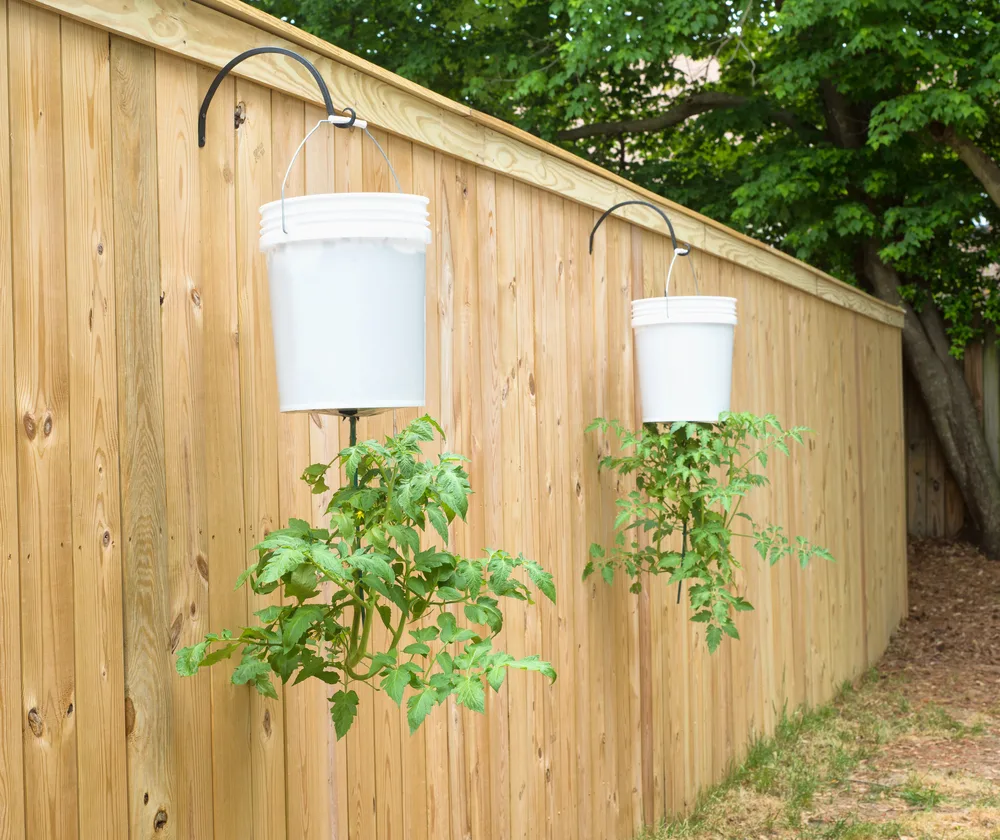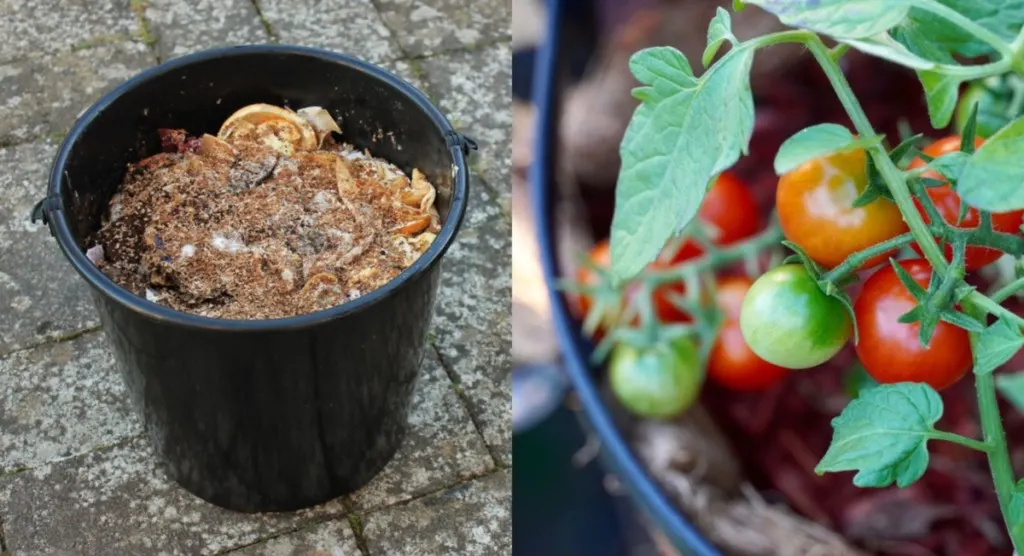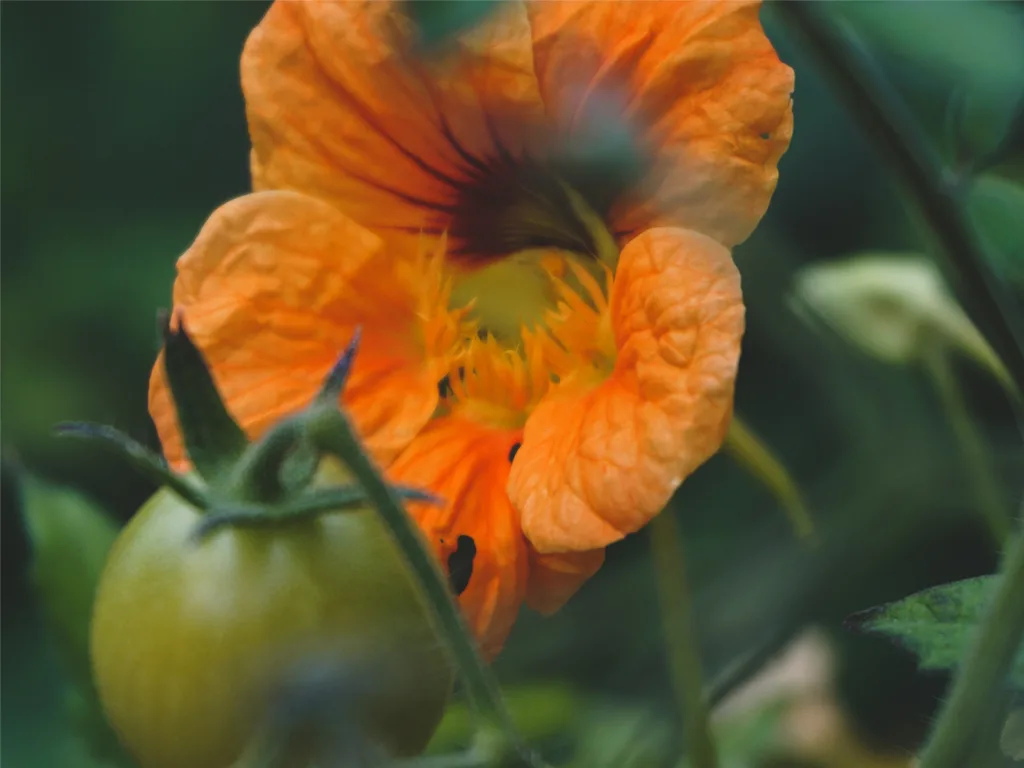
Tomatoes are one of the most popular edible plants to grow at home. Depending on your climate, you may grow them outdoors, or in a greenhouse or polytunnel.
You might even grow them in containers on a patio, balcony or sunny windowsill – or even upside down.
Related Reading:
Wherever you grow your tomatoes, companion plants can help you increase the yield from your crop.
Companion planting can help you boost the number of tomatoes you can harvest. It can help you increase resilience in your garden, cope with pests and maintain fertility.
It can also allow you to grow more food in less space.
What is Companion Planting?
Companion planting is simply the process of planting different plants together. It is a far better alternative to mono-crop cultivation.
Examples of companion planting include:
- layered forest gardens
- smaller scale fruit tree ‘guilds’
- polyculture annual garden beds
- individual companion plants for edible crops in containers
- inter-cropping (of agricultural crops).
In permaculture gardens, smallholdings and on organic farms, biodiversity is one of the keys to successful growing. We plant as many different plants as we can.
But companion planting is not about cramming in as many plants as we can in a random way.
Instead, it involves thinking carefully about how different plants will benefit from their neighbors, and how plants can help each other in a range of different ways.
The more beneficial interactions we can create, the more stable and resilient an ecosystem will be.
The Different Types of Companion Plants
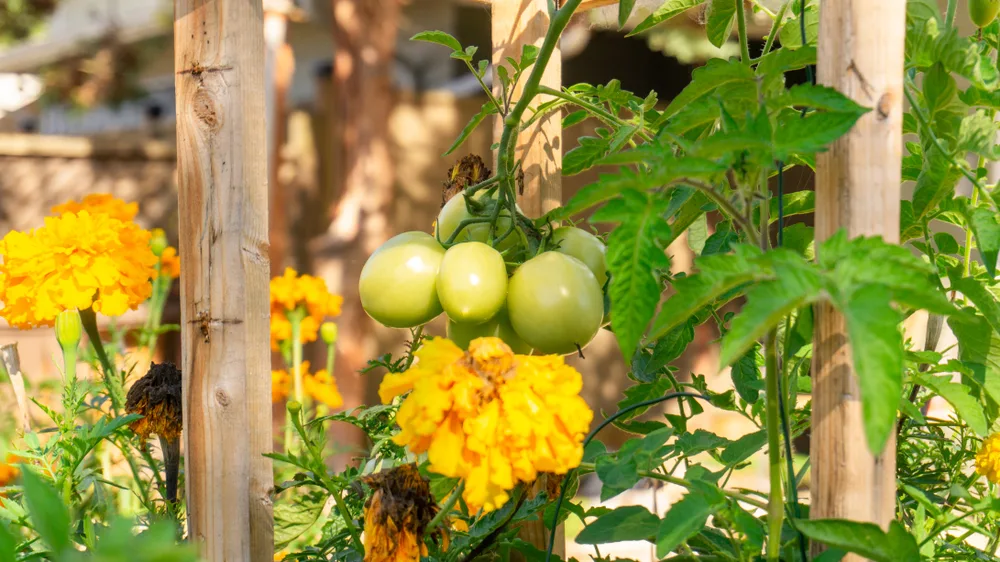
Before we start to look at the options for companion plants to grow with your tomatoes, we should look at the different types of companion plants.
This should help you understand why we companion plant, and the benefits it can have in your garden or growing areas.
Making The Most of Space and Time
Some companion planting is all about maximising yield on a given site. It is important to make the most of the land and make sure that it is giving all it can, and can continue to give sustainably.
By layering plants in space and through time, you can gain a higher yield than by simply planting one crop and watching it grow.
Though companion plants sown together can sometimes lower the yield of individuals, overall, the yield can be increased.
This can be true in a home garden or on a much larger commercial property.
One example of this is lettuces inter-planted with crops in the brassica family. Lettuces can be harvested before the brassica plants reach maturity.
Dynamic Accumulators
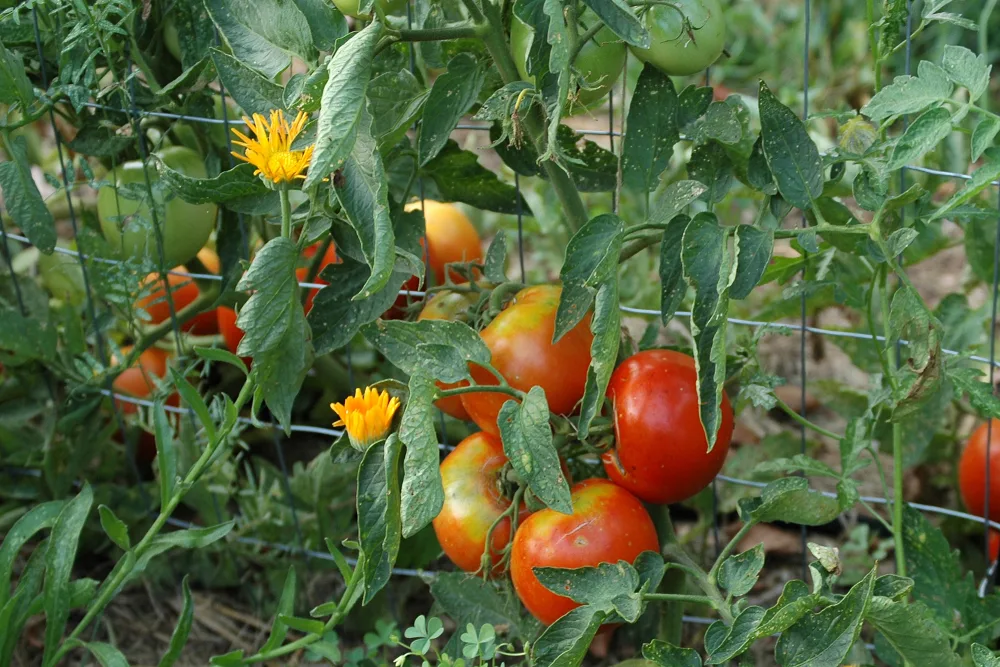
As well as companion planting to maximise yield, companion planting can also help to increase the amount of nutrients available in a given piece of soil and made available to crops.
Plant companions which gather nutrients either from the air or from deep in the soil and make them available for the use of other plants near them are called dynamic accumulators.
Beneficial companion plants of this type include peas, beans and other nitrogen fixers, which take nitrogen from the air and bring it into the soil in a usable form with the help of micro-organisms living on the roots.
Another well known and extremely useful dynamic accumulator is comfrey, which has deep roots.
When chopped and dropped, comfrey can take nutrients from deep under ground and make them available in the topsoil.
Comfrey can also be used to make a nutrient rich liquid fertilizer.
Pest Controllers
Some companion plants are extremely useful because they distract or repel pests that could otherwise decimate your crops.
Companion planting of carrots and onions, for example, is beneficial because the strong smells of both distract pests to either one.
Marigolds should be sown throughout a garden because they give off a powerful scent that repels many pests and French Marigolds give off a chemical from their roots that acts as a powerful pesticide for several years and can kill harmful nematodes in the soil.
Beneficial Attractants
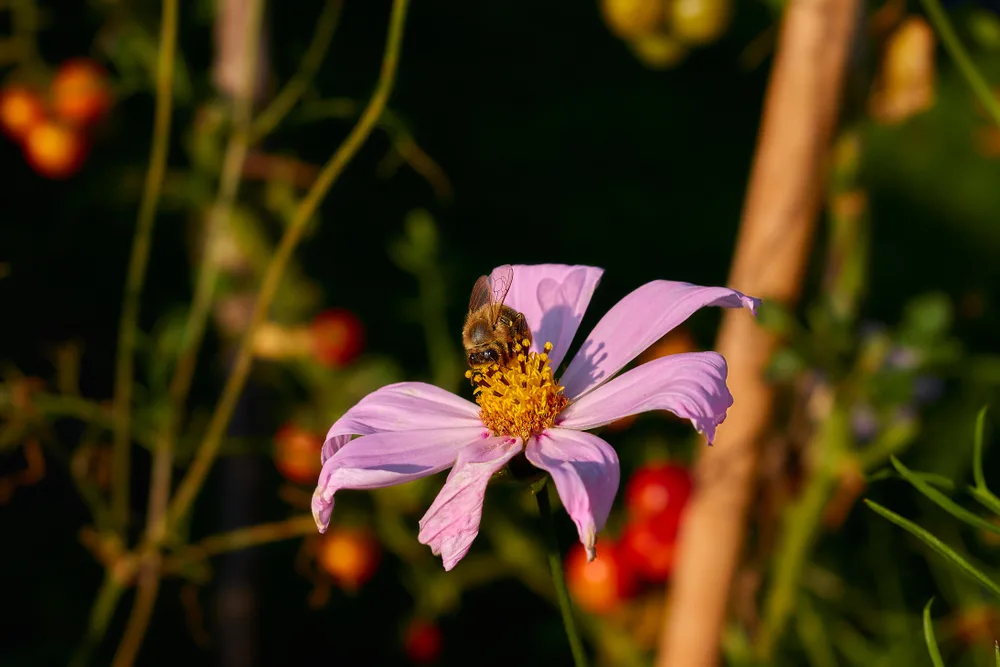
Other companion plants aid crops in a different way, not by repelling pests but by attracting the predatory insects and other creatures which can help keep pest numbers down.
Attracting creatures that prey on pest species can help keep the garden or farm ecosystem in balance.
Beneficial attractants also include those plants which attract pollinators like native bees to your crops.
Without these pollinators it would be difficult to gain any harvest and so it is important to make sure that you have companion plants which will attract them to the area and keep them there.
Environmental Aid
Finally, some companion plants help their neighbors by helping to enhance the environment in some way.
For example, some plants might cast beneficial shade. Others might provide a support for other growing plants. Some plants create good ground cover.
This can reduce competition from weeds, reduce water loss, and keep soil healthy.
When choosing companion plants, it is important to keep a kind of balance sheet of pros and cons.
For example, a companion plant might compete with tomatoes for water and nutrients. But this negative may be outweighed by its other benefits.
It is important to realise that the science of companion planting is not much studied, nor are plant interactions fully understood.
We don’t know everything about plants by any means. But we do know enough to know how little we actually know.
The anecdotal evidence for the benefit of certain plant combinations does stack up. But there are few peer-reviewed scientific studies to actually back up these results.
Many of the nuances of plant communication and interaction are still lost on us.
But by experimenting with combinations that may work, and noting our results, we can begin to build up a picture of what works well for us where we live.
Remember, what works well in one climate, or one soil type and conditions, may not work well in another.
Companion planting is all about experimentation, with a good amount of common sense and basic ecosystem knowledge thrown in.
That said, let’s take a look at some companion plants that may work well when planted alongside tomatoes.
Vegetables & Fruits To Companion Plant With Tomatoes
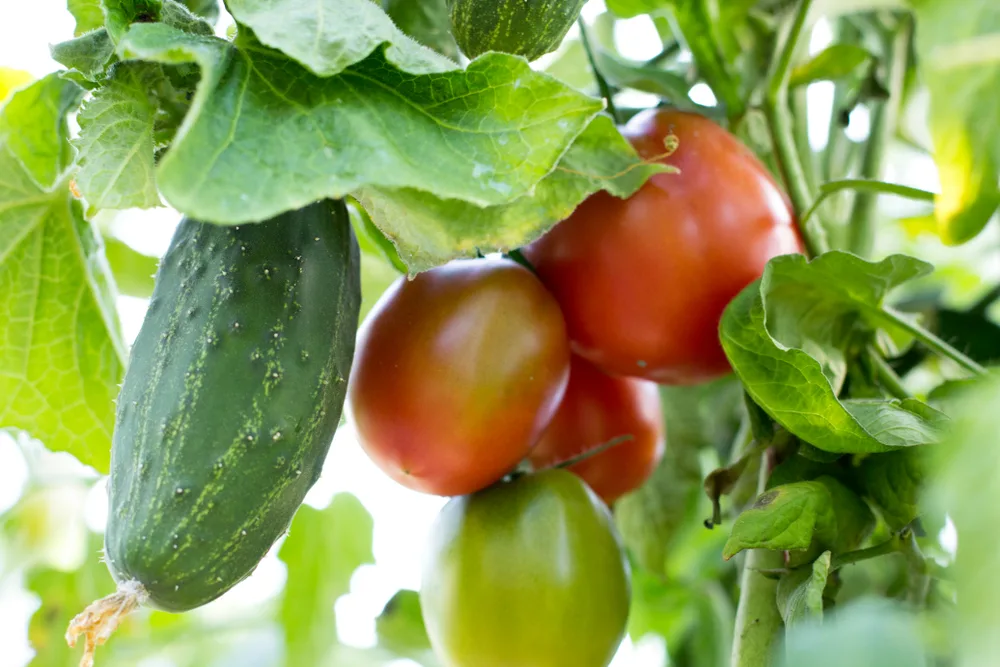
If you are growing your tomatoes in an annual growing area, you must consider a number of different factors when choosing companion plants.
Often, it will be important to think not only about space but also about time.
You should think about whether companion plants will be grown alongside tomatoes right up until harvest, or grown as an interim crop before your tomatoes really get going.
It will also be vital to consider your crop rotation plan. What comes before and after your tomatoes is often just as important as what is planted with them.
When planning a planting layout and crop rotation plan, these are some other fruits and vegetables that you could plant alongside your tomatoes:
1. Peppers
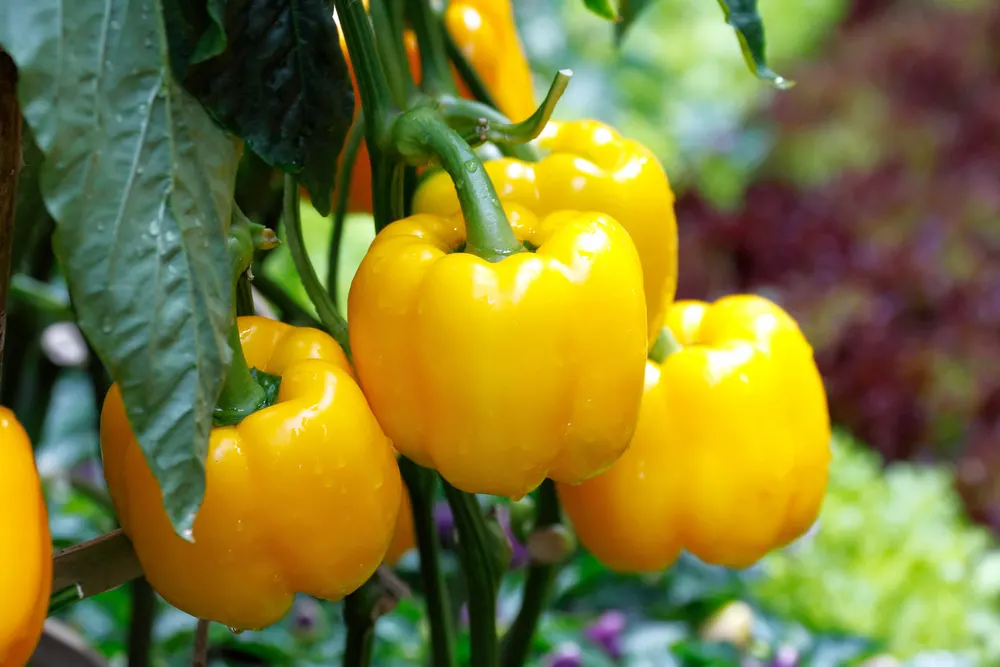
This suggestion comes with a caveat. Some gardeners and gardening books will tell you to never plant members of the Solacaceae family together. This family includes potatoes, tomatoes and peppers.
The reasoning goes that planting these crops together can be problematic because diseases (like blight, for example) can easily spread between them.
However, bigger problems arise with diseases etc. when you grow members of this family in the same bed after one another. Growing them together, therefore, can sometimes be the better option.
By planting tomatoes and peppers together, you can move them together in a crop rotation system. This can make things easier in a smaller space.
What is more, tomatoes and peppers grow at the same time, and like similar conditions. And peppers can benefit from the shade and humidity created by the tomato plants close by.
2. Asparagus
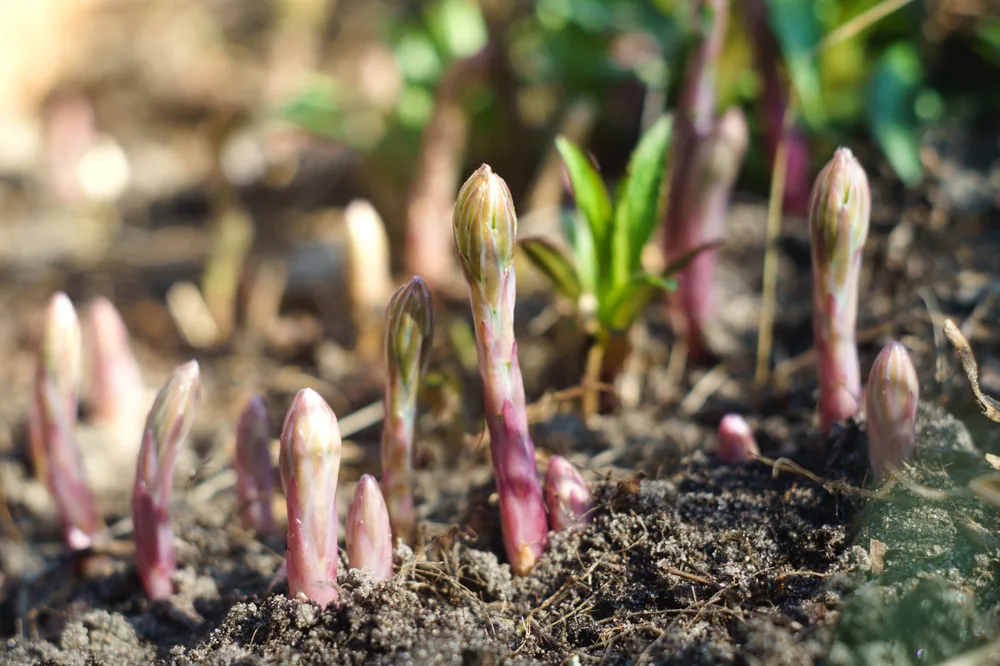
Asparagus is one of the better known perennial vegetables. But asparagus beds can take a while to become established.
And once the asparagus has been harvested in spring, the bed may see no action for the rest of the year.
Rather than leaving the bed largely empty between asparagus harvests, it can be a good idea to plant tomatoes (and other companion plants) to take up the time and space.
3. Carrots
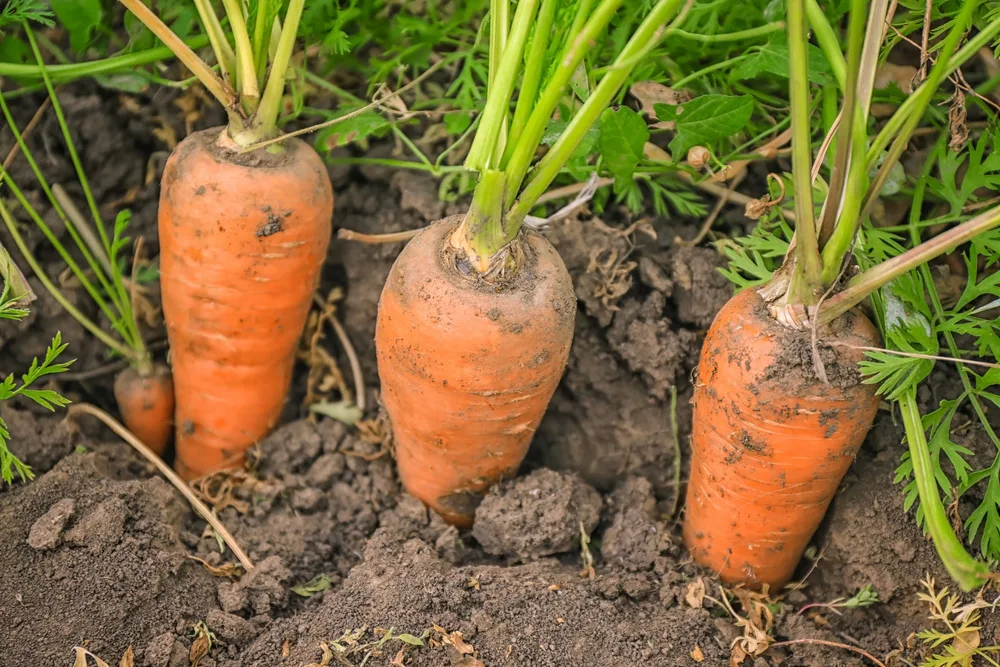
Carrots can also be companion planted with tomatoes and many people believe that though carrots will be a bit smaller as a result, overall yield will be improved.
Rather than planting carrots at the same time, it may be better to consider overlapping the cropping times of the plants, planting and harvesting early carrots in the tomato bed before they really take off, and perhaps adding a second crop once the tomato plants are past their best.
4. Celery
Tomatoes can also be planted in the same bed as celery without any harm to either crop. The celery may also benefit from the shade from the tomato plants.
However, I tend to fit celery in with brassicas, since the celery is said to repel the cabbage white butterfly.
And members of the cabbage family should not be grown with tomatoes.
5. Beans
Tomatoes are not a particularly nitrogen-hungry plant. They need a good boost of potassium to flower and fruit well.
But nitrogen fixing beans are generally a good plant to scatter all around your garden, and tall climbing beans can work well between and amongst cordoned tomato plants.
6. Squash
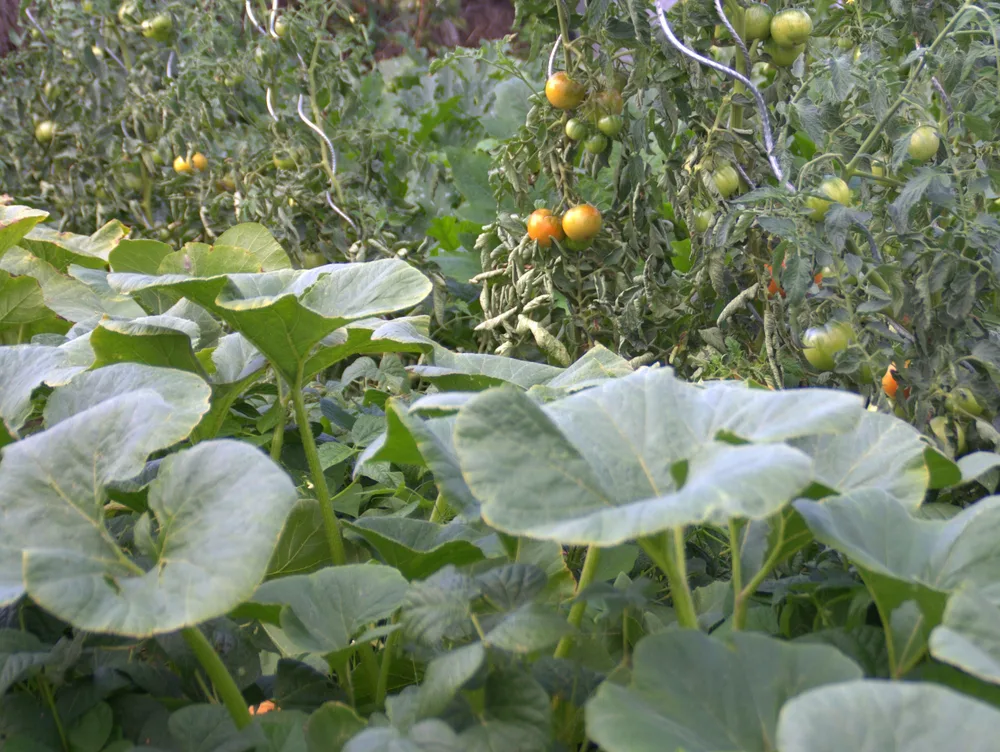
Beans are often planted alongside squash, since they are nitrogen-hungry.
These two feature in the famous companion planting combination – the ‘three sisters’ (along with corn). I would not recommend growing corn and tomatoes in the same bed.
But along with tomatoes and perhaps beans, squash could serve the same function that they do in that other guild.
Their spreading form and large leaves means they create good ground cover, reducing water loss from the site. Squash and tomatoes also require similar growing conditions, and so can work well together.
7. Cucumber (And Other Cucurbits)
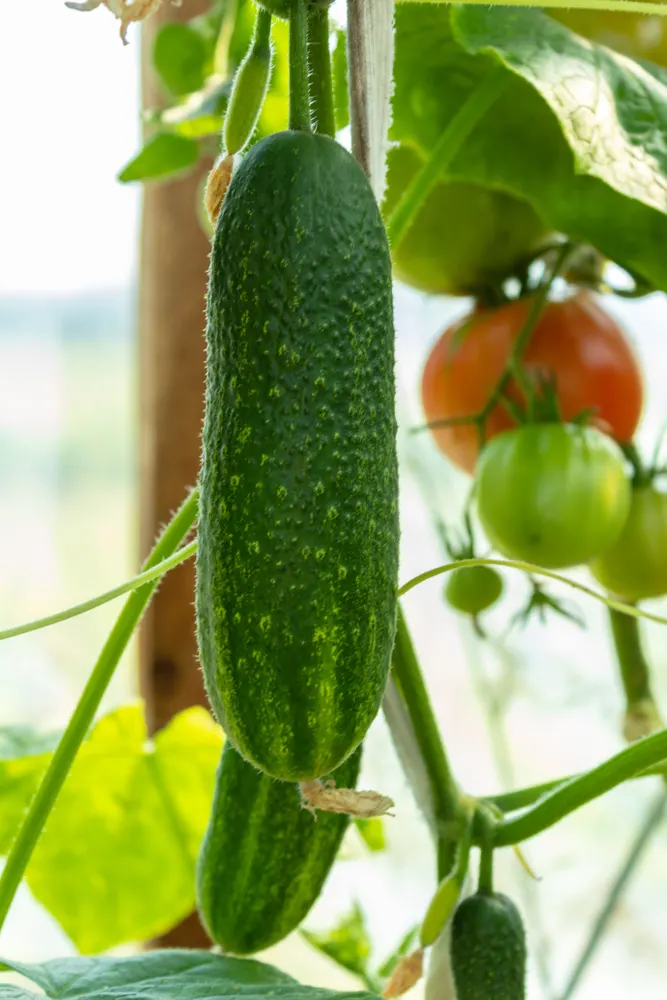
Cucumbers (and other members of that plant family) can also work well with tomatoes.
They too share similar needs in terms of their environment and growing conditions.
And they, like tomatoes and beans, could also be grown up cordons or supports to make the most of a smaller growing area.
8. Garlic, Onions, Chives (and other Alliums)
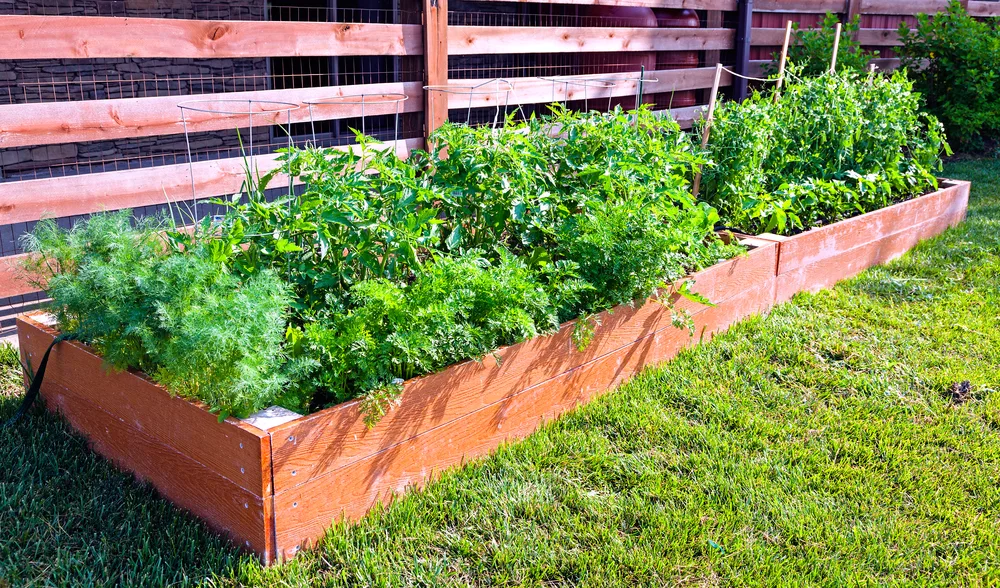
Garlic, onions, chives and other alliums all work well as companions to a number of other plants.
Their strong smell can repel a range of pests that might otherwise bother your tomatoes.
9. Lettuce (or Other Low-Growing Leafy Greens)
Lettuce and other low-growing leafy greens can also be slotted into spaces between and beneath tomato plants.
They can be used to fill gaps between growing tomato plants early in the season, and to create ground cover to retain soil moisture and reduce weeds.
In summer, the shade cast by your tomato plants will also prevent lettuce from bolting and prematurely going to seed.
Herbs To Use as Companion Plants For Tomatoes
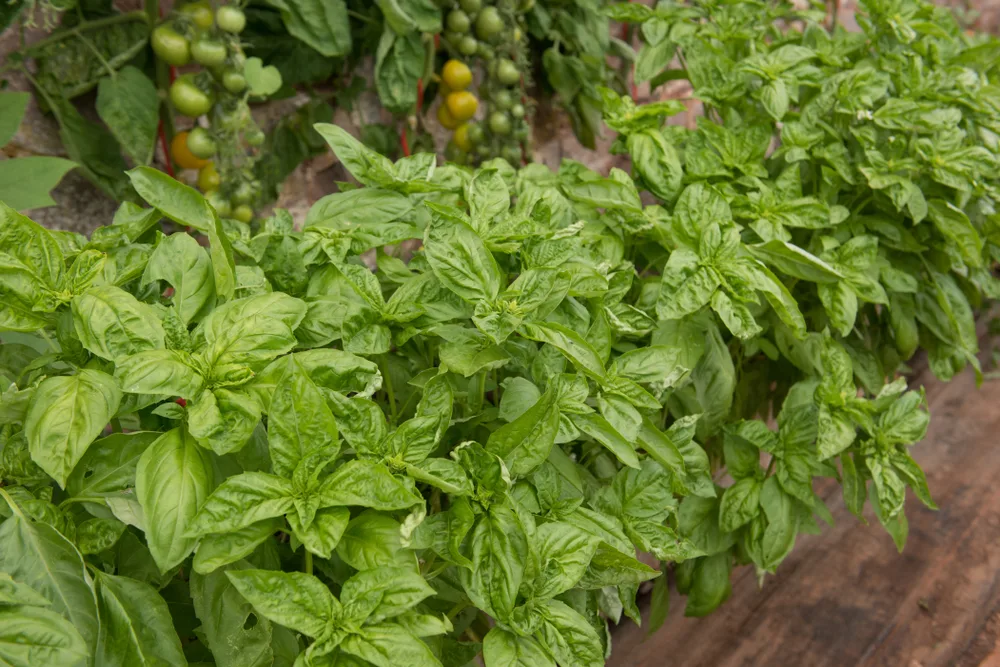
Tomatoes grown in an annual polyculture can also benefit from herbs grown nearby. Annual herbs can be rotated in your annual areas with your fruits and vegetables.
Perennial herbs can be planted on the fringes of such an area, or even grown in pots or containers nearby.
You might further embrace permaculture ideas by creating mixed polycultures that retain both annual and perennial elements. Tomatoes might find a space, for example, in gaps in a perennial herb garden.
Herbs are also great choices for companions if you are growing tomatoes in containers.
Many can fill in the gaps around the edges of the containers and help reduce watering needs.
Wherever you use them, of course, many herbs attract beneficial insects, and can also delight human inhabitants with their scents.
Here are some herbs to plant alongside tomatoes:
10. Basil
Basil and tomato go very well together on the plate. And they go very well together in the garden too.
Tomato and basil is a classic companion planting combination. Basil is great for tomatoes.
It repels a range of insect pests, improves the growth of nearby tomato plants, and is even said to make the fruits taste better.
11. Mint
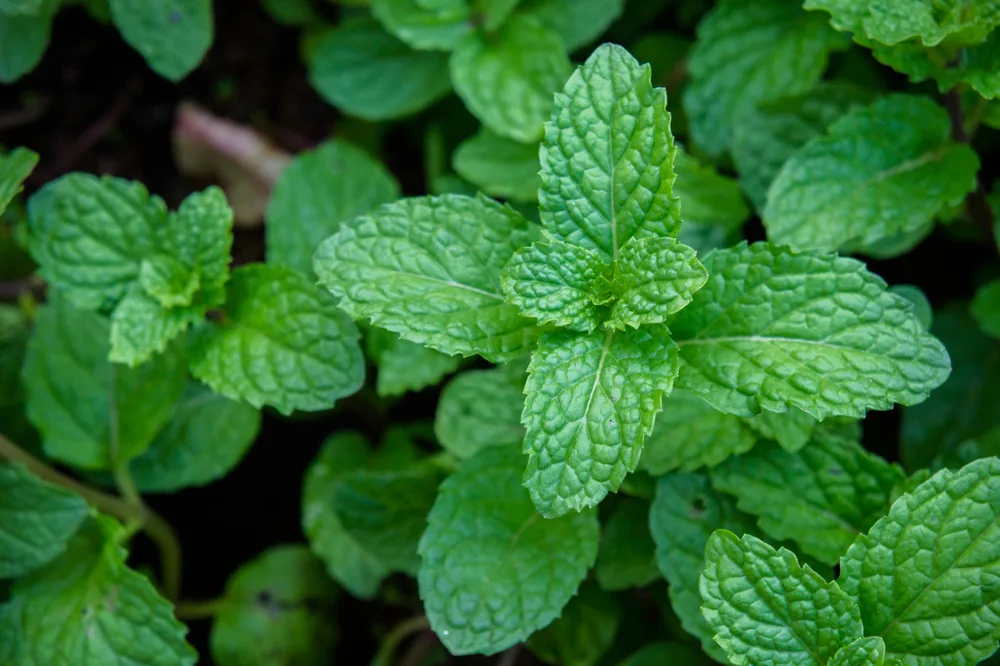
Mint is also a fragrant herb that can repel certain pest species. It too is said to improve the health of the tomato plants grown nearby.
Over time, mint, like basil, can also spread around the base of the plants and create good ground cover.
12. Parsley
Another aromatic herb that may be of benefit between or near tomato plants in parsley.
Not only will the parsley help the tomatoes with ground cover, the tomatoes may also help the parsley by providing shade during the heat of summer.
13. Bee Balm
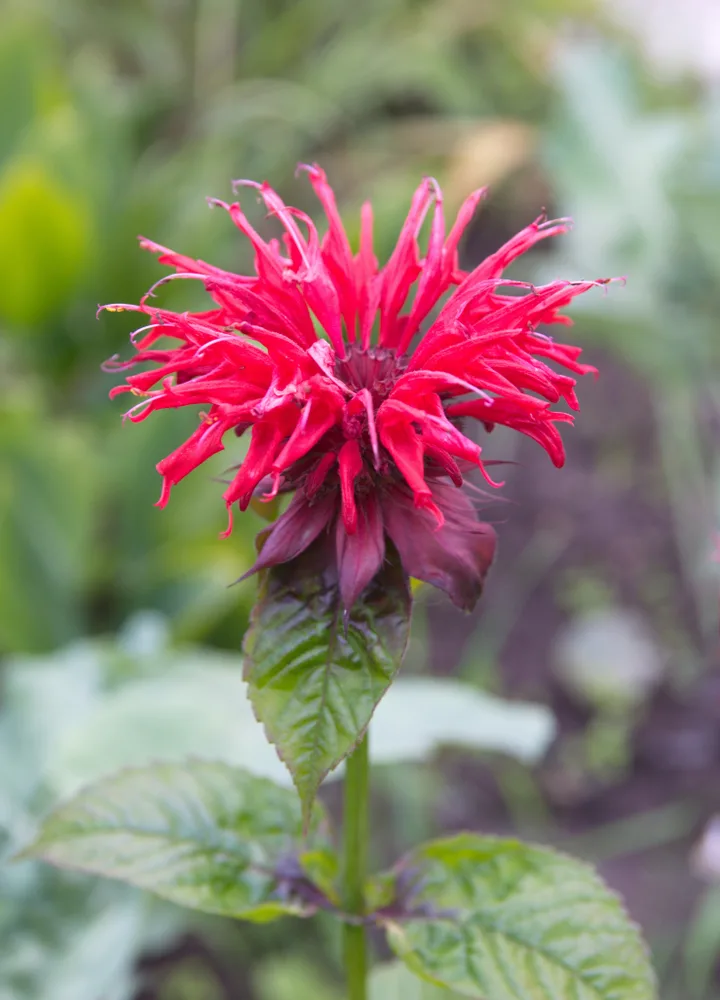
With bee balm, the name says it all. This is a great bee-attracting plant.
It will bring pollinators into your garden to pollinate your crops. And as another aromatic herb, it may improve the health and flavor of your tomatoes.
14. Cilantro
Cilantro can repel certain insect species and repel others. This is another herb that works well with tomatoes in the garden as well as in the kitchen.
15. Oregano
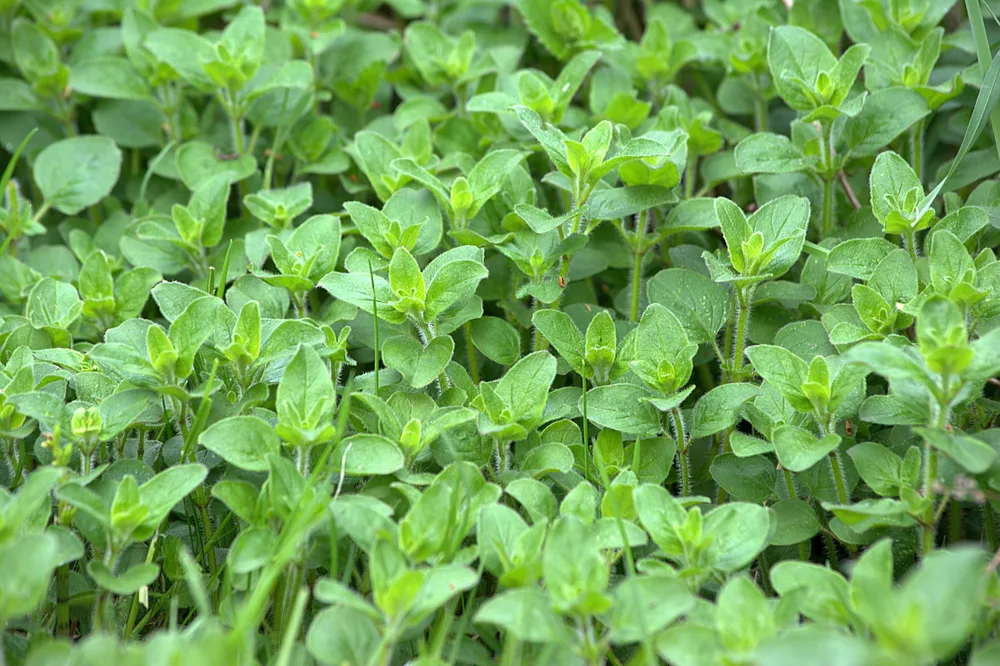
Again, oregano works well with tomato in the ground as well as in a range of dishes. As an aromatic herb, it makes an excellent companion for a number of different plants.
16. Marjoram
Tomatoes love warmth in the summer and perennial Mediterranean herbs do too. Marjoram is one example. It is especially beneficial for attracting insects when in flower.
17. Rosemary
Rosemary is another Mediterranean herb and while it won’t want to get too wet, it too can thrive in similar temperatures to tomatoes. But keep it on the fringes of a tomato growing area, rather than as a direct neighbour to your plants.
18. Thyme
Another Mediterranean herb to consider for your tomato bed or container is thyme. Thyme is not only great for attracting beneficial wildlife, it can also create good ground cover around the edges of a tomato bed.
19. Sage
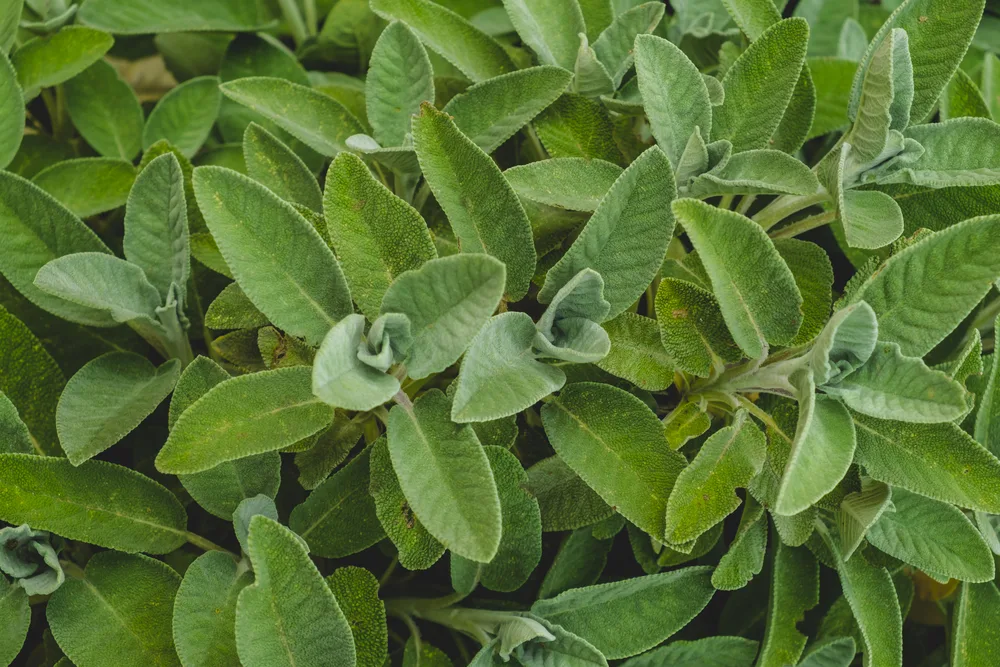
Sage also does well planted around the edges of a tomato container or growing area and, like so many other herbs, will help attract the insects you want and repel those you do not want in your garden.
20. Anise
Again, anise attracts a range of beneficial insects. It is also said to improve the essential oil yield of other aromatic herbs planted nearby, so may increase other companion plants’ efficacy.
21. Horehound
Horehound will attract Braconid and Icheumonid wasps and Tachnid and Syrid flies to your garden. It is said to improve the fruiting of tomatoes and peppers grown nearby.
Tomatoes planted with horehound are said to crop for longer and crop more heavily.
22. Lovage
Lovage is another herb said to benefit tomatoes. Plant lovage and, again, this will help bring plenty of beneficial insect species into your garden.
23. Hyssop
One more herb that you might not have considered is hyssop. Hyssop is also said to be beneficial for tomatoes and also improves insect biodiversity, bringing in predatory species.
Flowers to Use as Companion Plants For Tomatoes
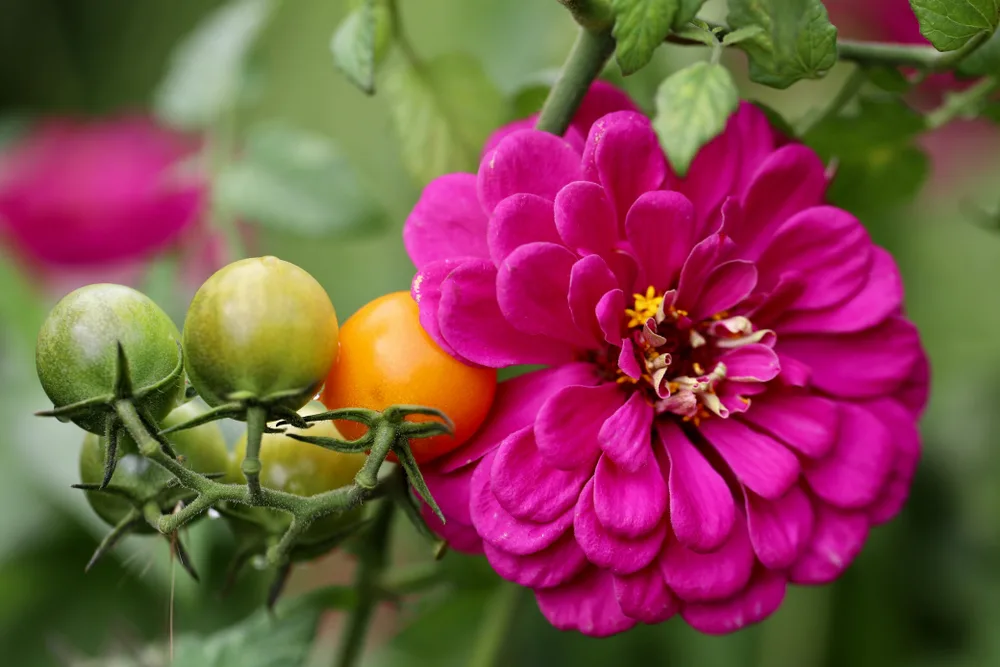
Flowers can also be great companions for tomatoes in beds, borders or containers. Again, they can be annual or perennial, and be included in a wide range of different garden zones.
Too many gardeners create division between their fruit and vegetable plot and their ornamental flower beds. But integration is always better than segregation.
Here are some flowers you should consider growing with your tomatoes:
24. Borage
Borage’s beautiful blue flowers look great against tomato plants. But more than this, borage is an excellent companion plant because it deters tomato hornworms.
Beneficial insects like bees and other pollinators also love its blossoms. And flowers are produced over the long period, leading right up to the last frost.
25. Marigolds
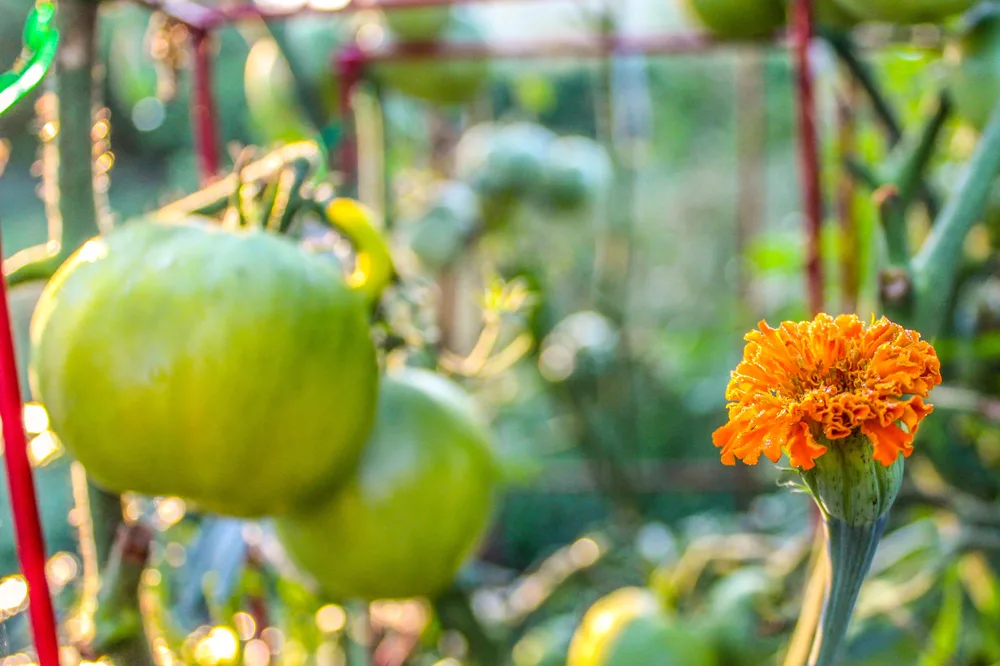
Research has suggested that planting marigolds in between tomato plants is beneficial because the marigolds like similar conditions.
But it can also help because them can excrete a chemical from their roots which kills harmful root-knot nematodes in the soil and stop them from spoiling your tomato plants.
26. Nasturtiums
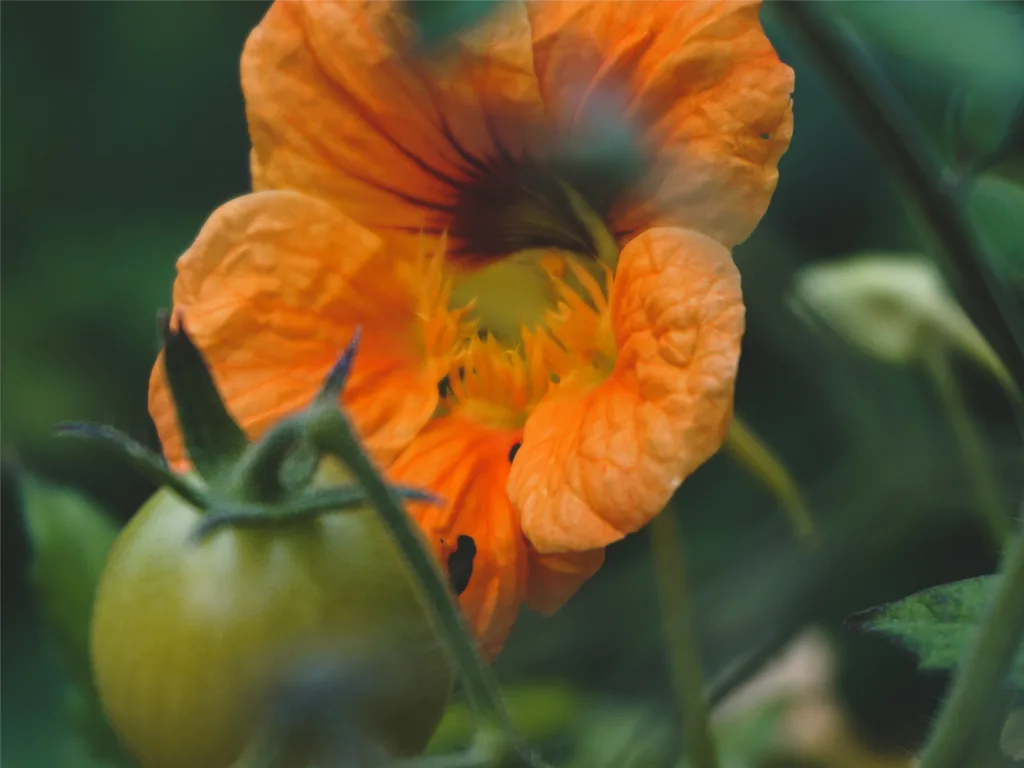
Nasturtiums planted a short distance from tomatoes can act as a trap crop – luring aphids to feast on them rather than on your prize tomatoes.
The attractive flowers also drawn in beneficial aphid predators, as well as providing a beneficial additional edible crop.
27. Petunia
Petunias can look good planted close to your tomatoes. But they can also be beneficial because they naturally deter a wide range of insects that could pose a problem for your tomato plants.
28. Calendula
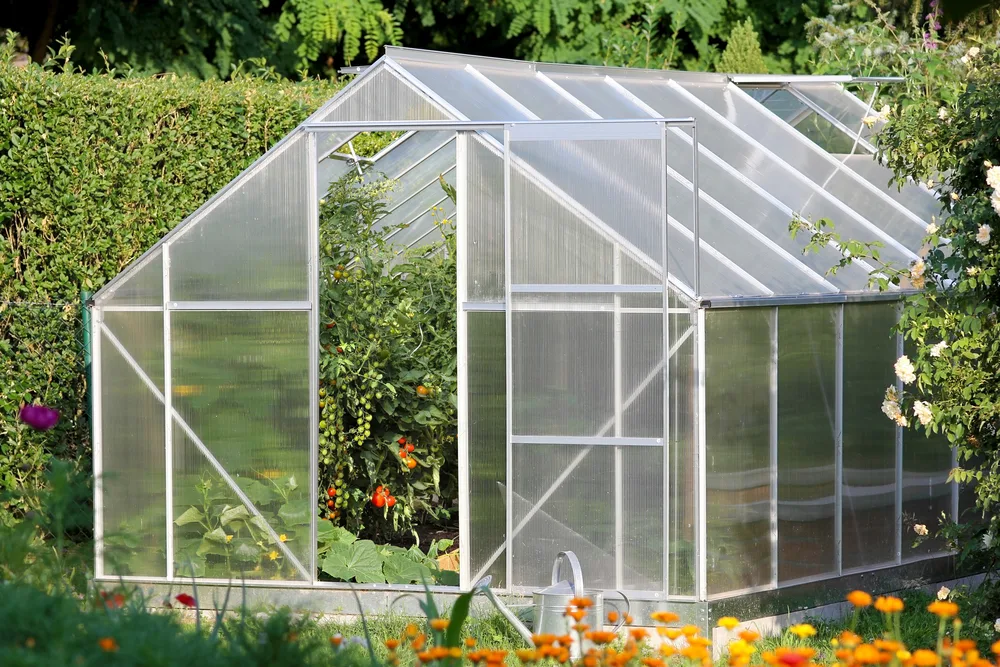
Calendula is another flower that can also be an edible crop. It can also be used in a wide range of other ways around your homestead.
Plant it near tomatoes and this is another crop that will draw in a wide range of pollinators over a long blooming season.
29. Amaranth
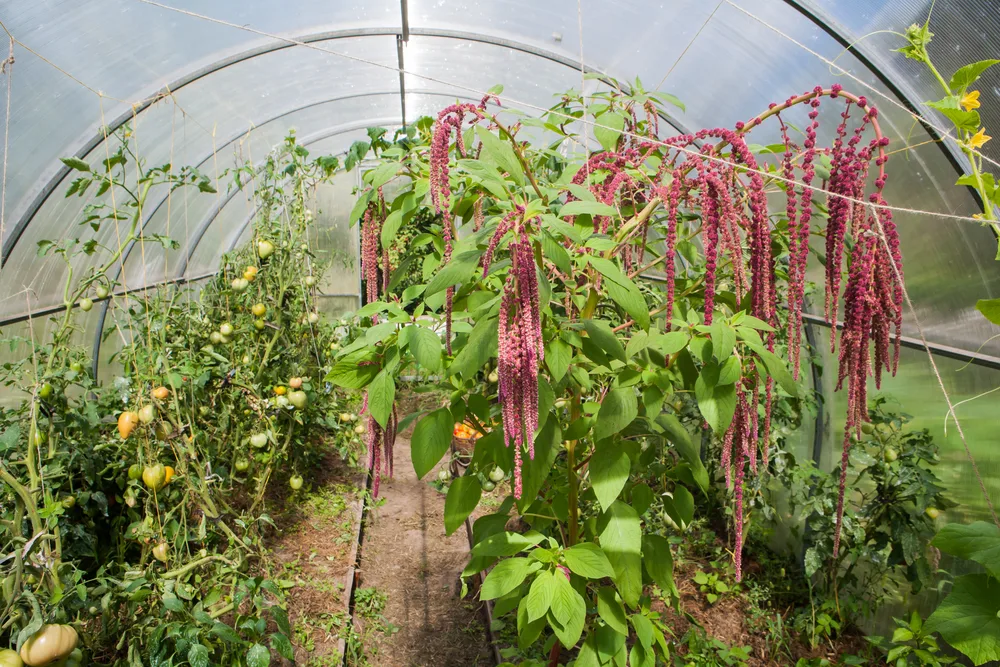
Amaranth is another great companion for tomatoes. Amaranths host beneficial predatory beetles which can predate the bad bugs that bother your tomato plants.
Amaranth can also provide its own beneficial yield, in the form of greens or seed.
Wildflower Strips
One study showed that flower strips planted along the edge of a tomato cultivation area acted as a trap crop and reduced damage from sap-sucking insects to the crop itself.
So you could plant not only the flowers mentioned above, but a wide range of native flowers for beneficial effect.
Weeds To Allow to Grow in Your Tomato Garden
One final type of plant to consider are those commonly called ‘weeds’. Plants that are often called weeds can, in the right places, be incredibly useful and resilient.
Here are some weeds that it may actually be beneficial to allow to grow close to your tomatoes:
30. Yarrow
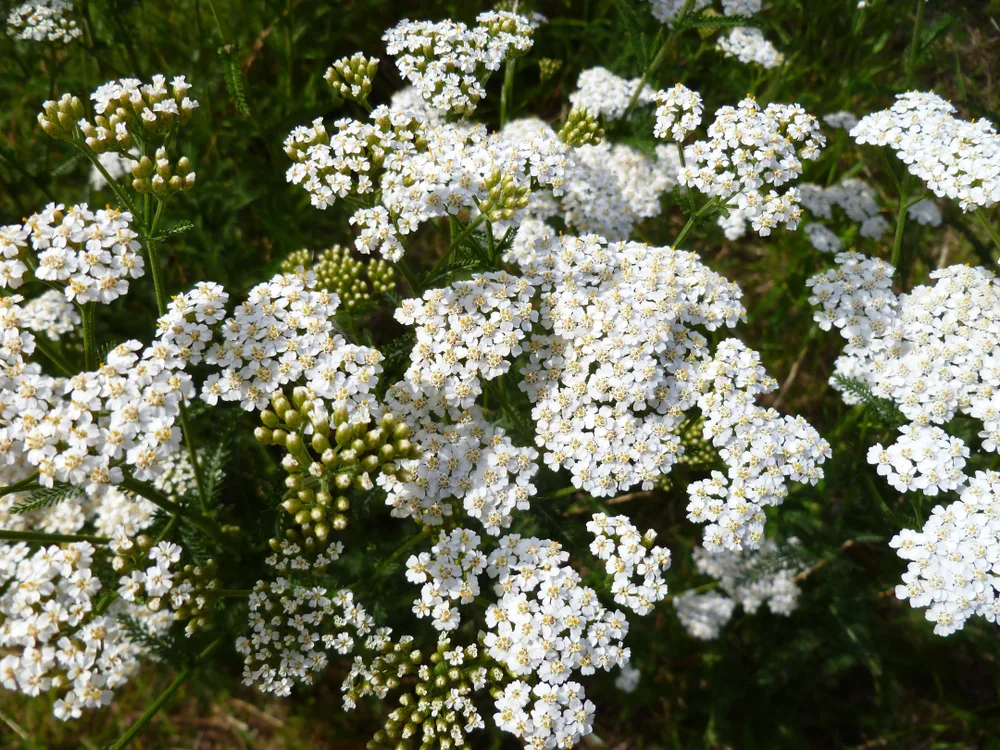
Yarrow is often considered to be a weed. But it can be beneficial as a companion plant to a wide range of crops – including tomatoes.
It is great at attracting syriphidae that eat aphids. It also improves soil quality as the leaves are used as a mulch or to enrich your compost.
31. Stinging Nettles
Stinging nettles may not seem like a wonder-crop. But having nettles in your garden can be beneficial in a range of different ways.
Stinging nettles attract a range of caterpillars and beneficial insects.
They are naturally repellent to aphids and the roots have anti-fungal properties.
A few nettles around your tomato patch could be a great thing – and you can even eat them or use them in a range of other ways around your homestead as an additional yield.
32. Dandelions
Dandelions are another surprising edible that many people just think of as a common weed. But their deep tap roots are also great at bringing nutrients up to the soil surface when chopped and dropped before they go to seed.
And the cheery yellow flowers attract beneficial insects too. What is more, they also release ethylene gas, so could allow your fruits to ripen more quickly.
33. Sow Thistle
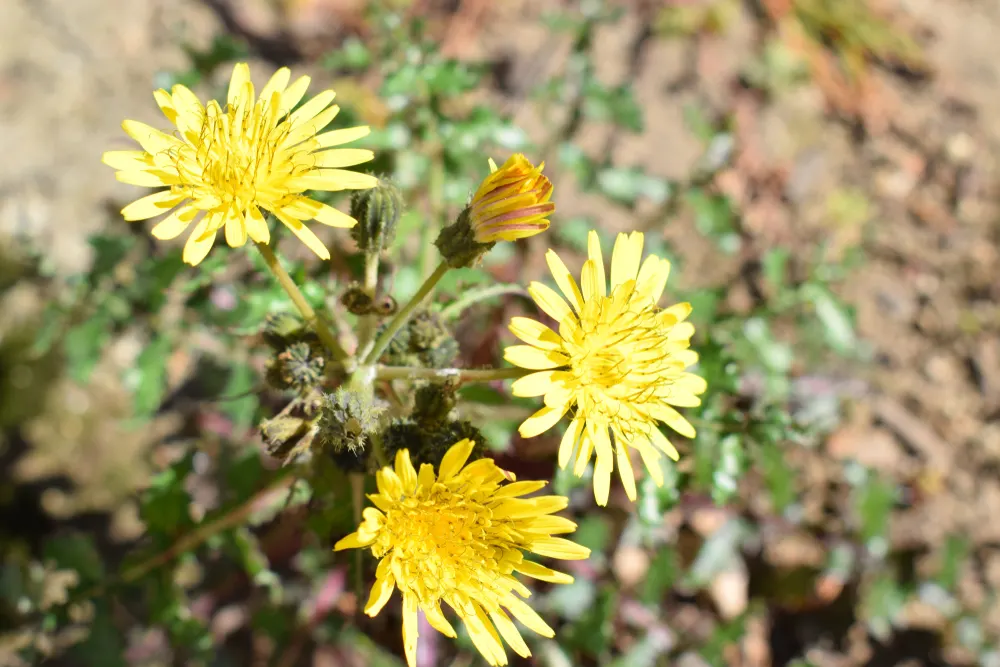
Sow thistle is another common weed which is said by some gardeners to aid the growth of other plants close by. Like the dandelion, it has a deep tap root that can bring up nutrients from far below the soil surface.
34. Chickweed
Chickweed is good for foraging hens, but we can eat it too. And a blanket of this spreading weed around the base of tomatoes can help to reduce soil moisture evaporation.
This good ground cover plant can also reduce competition from other weeds – and you can eat it long before the nutrients are required for fruiting, mature tomato plants.
35. Purslane
Finally, purslane is another edible weed that could be good for creating ground cover around tomato plants. It could be particularly beneficial in areas with lower rainfall, or where water is scarce.
Examples of Tomato Polycultures To Consider
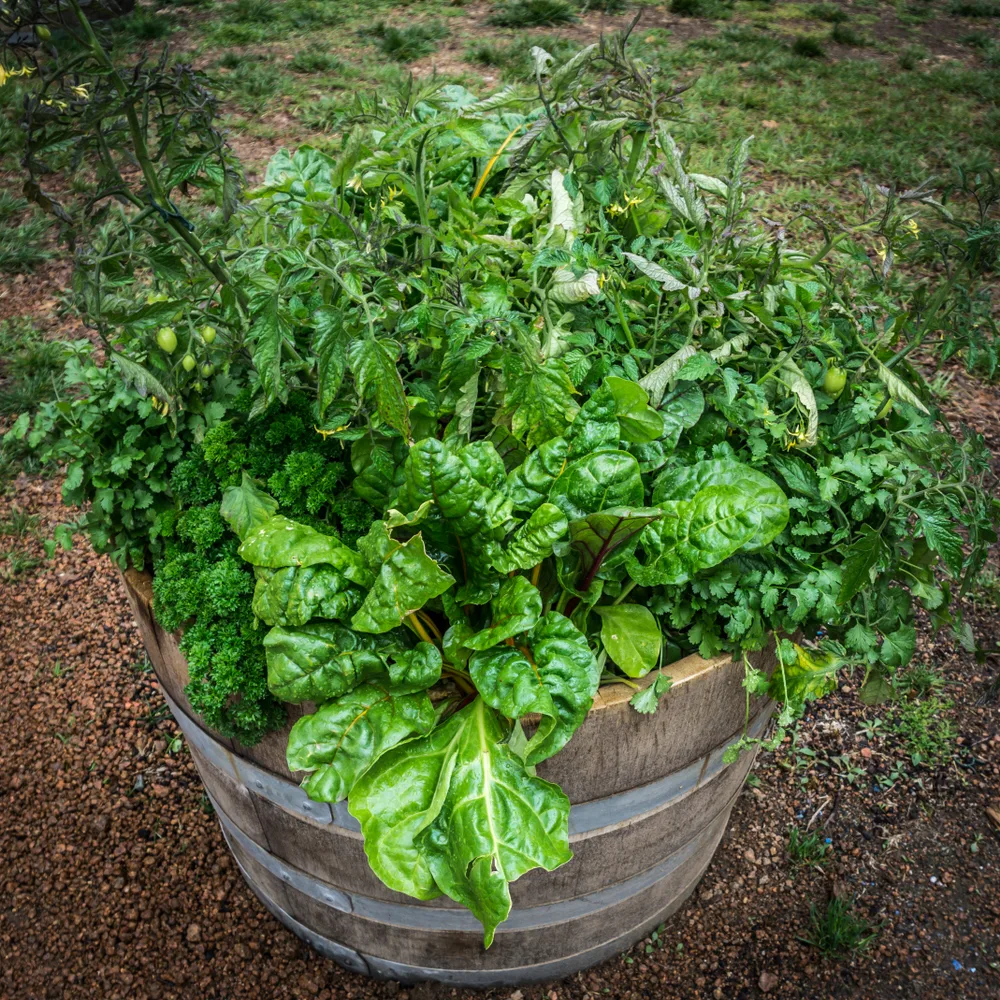
One thing to remember when creating your polycultures and companion planting schemes is that while all of the above plants may work well with tomatoes, they may not all work well with one another.
There are so many different elements to consider. It can be difficult, when new to companion planting, to come up with schemes that will work.
To help you begin to formulate your own companion planting plan, here are a few companion planting schemes that others have used. Perhaps one of these ideas will be the right mix for where you live?
A Tomato Ring – With Beans, Cucumbers, basil, lettuce and nasturtiums
Companion Planting for Tomatoes @ insteading.com.
Tomatoes, Borage and Squash
A Companion Planting Trio @ thespruce.com.
Tomatoes, Runner Beans, Butternut Squash, Basil, Marigolds, Cornflower, Self-Seeded native Plants
Permaculture Design: Vegetable & Herb Guilds @ permaculture.co.uk.
Tomato, Garlic, Basil, Parsley, Oregano, Nasturtium, Borage, Asparagus
Guilds for the Small Scale Home Garden @ permaculturenews.org
Tomato, Asparagus, Onions, Carrots, Basil, Dandelions
Tomato Guild @ rubberdragon.com
Tomatoes, Carrots, Onions, Basil, Marigolds, Calendula, Parsley
Tomato Guild @ thegardenladyofga.wordpress.com
These are just a few examples of the polycultures you can create around tomato plants with companion planting. But why not try some experimentation. See what works best where you live?
Read Next:

Get the famous Rural Sprout newsletter delivered to your inbox.
Including Sunday ramblings from our editor, Tracey, as well as “What’s Up Wednesday” our roundup of what’s in season and new article updates and alerts.



